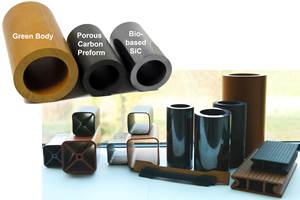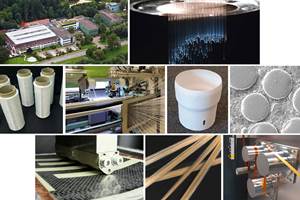ORNL, Sierra Space create novel C/SiC TPS for reusable space vehicles
CMC tiles will be used on the Sierra Space DC100 Dream Chaser spaceplane carrying critical supplies and science experiments to and from NASA’s ISS.
Researchers with the Department of Energy’s (DOE’s) Oak Ridge National Laboratory (ORNL, Oak Ridge, Tenn., U.S.) and Sierra Space Corp. (Louisville, Colo., U.S.) have developed a novel carbon fiber-reinforced silicon-carbide (C/SiC) ceramic matrix composite (CMC) thermal protection system (TPS) for reusable commercial spacecraft. The TPS is composed of a tile face and an insulative tile backing that, when installed on a space vehicle, will be able to withstand multiple launches and the extremely high temperatures of atmospheric re-entries over short periods of time.
The TPS composite material merges the high temperature and corrosion stability properties of a SiC matrix with the high strength and high-temperature consistency of carbon fiber reinforcement. The two materials are combined into a low-density, low-profile composite thermal barrier that is critical for providing insulative protection and stable flight dynamics.
“Keeping a consistent outer mold line is important for reusability,” says ORNL principal investigator Greg Larsen, referring to the need for a smooth exterior surface. “It keeps the aerodynamics the same to allow the vehicle to fly as designed.”
Larsen explains the properties of the tile will help maintain the aerodynamic surface over multiple flights by resisting changes to size and shape caused by exposure to extreme heat. The TPS material’s light weight will also help maximize usable commercial payload and internal vehicle volume.
The team leveraged 30 years of lessons learned from NASA’s Space Shuttle program to develop the TPS. First used in 1981, the NASA shuttle orbiter’s TPS is still considered state-of-the-art thermal protection technology for space vehicles. The design called for each shuttle to be fitted with more than 24,000 6 × 6-inch tiles made to fit an exact location on the surface of the lower portion of the spacecraft. The tiles were formed in a labor-intensive process by pouring water and chemicals into a mold and sintering the mixture at a temperature of up to 2350°C to create the final shape. Technicians used a special adhesive to attach the individual tiles to the outer skin of each orbiter.
According to Larsen, while the NASA program averaged nearly five launches per year, commercial space flight is moving at a faster pace today. “The key to achieving a flight cadence that is driven by fast landing-to-launch turnaround times is reusability of the TPS,” he says. “The materials we are exploring will push the boundaries of reusability that translate directly to commercial viability for space-access providers.”
ORNL and Sierra Space have completed the first material development phase of the project and have jointly applied to patent the novel material. The second phase of the project will focus on developing an enhanced manufacturing process that will produce the insulative tile backing.
Sierra Space plans to use the new TPS on the Sierra Space Dream Chaser, a winged commercial spaceplane. The multimission spaceplane fleet is designed to transport crew and cargo to low-Earth orbit. The company plans to use the TPS on the DC100 Dream Chaser that will carry critical supplies and science experiments to and from the International Space Station (ISS) under a NASA Commercial Resupply Service contract.
TPS research is being performed at DOE’s Manufacturing Demonstration Facility (MF) at ORNL. The MDF, supported by DOE’s Advanced Materials and Manufacturing Technologies Office, is a nationwide consortium of collaborators working with ORNL to innovate, inspire and catalyze the transformation of U.S. manufacturing.
Related Content
Bio-based SiC ceramics from wood polymer composites
Austrian research institute Wood K plus makes 95% silicon carbide ceramics more sustainable (>85% bio/recycled content), enables 3D shapes via extrusion, injection molding and 3D printing.
Read MoreA new era for ceramic matrix composites
CMC is expanding, with new fiber production in Europe, faster processes and higher temperature materials enabling applications for industry, hypersonics and New Space.
Read MoreNew CMC turbine vanes successfully tested in wind tunnel
SiC/SiC ceramic matrix composite (CMC) inlet guide vanes for a high-pressure turbine are aimed for a geared turbofan and show promise for more efficient aeroengines with less weight and need for cooling.
Read MoreDITF Denkendorf advances sustainable carbon fibers, oxide fibers for CMC and more
The German Institutes of Textile and Fiber Research are targeting more sustainable carbon fiber via low-pressure stabilization and bio-based precursors, and working with Saint-Gobain to commercialize oxide ceramic fibers for CMC.
Read MoreRead Next
“Structured air” TPS safeguards composite structures
Powered by an 85% air/15% pure polyimide aerogel, Blueshift’s novel material system protects structures during transient thermal events from -200°C to beyond 2400°C for rockets, battery boxes and more.
Read MoreArceon introduces novel CMC materials for space, defense
Carbeon C/C-SiC ceramic matrix composites are being developed and tested for rocket nozzles, onboard the International Space Station and in electric aviation, metal treatment and reactor applications.
Read MoreGoodman Technologies, partners scale up AI-empowered 3D printing of nanocomposites for spacecraft TPS
NASA project addresses the capability gap in TPS production and installation for space exploration and hypersonic systems, delivering an ARMs system, nanopaste and prepreg tapes, manufacturing verification coupons and more.
Read More



























